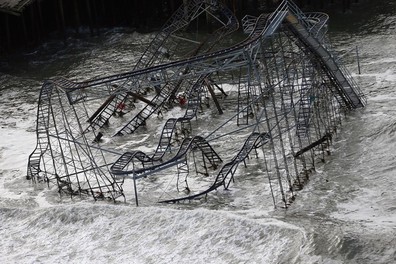Hurricane Sandy reawakened manufacturers to the inescapable fact that natural disasters are increasing as global warming advances. An estimated 10,000 manufacturing facilities were directly affected by Sandy. Flooding spoiled inventory. Soaked equipment has to be dried out and set to rights. Even undamaged plants were shut down for days, interrupting finely balanced supply chains.
Sandy’s cost has been estimated at $7 to $15 billion. The cost and number of storms, earthquakes, landslides, and other catastrophes around the world are trending up. In 2011, a record $380 billion in losses resulted from a near-record 820 so-called billion-dollar events. The biggest losses were $210 billion from the earthquake and tsunami in Japan and $40 billion from floods in Thailand. Less than a third of the world’s losses—$105 billion—were insured.
What does this mean for manufacturing? Let’s look at flooding risk. For centuries, as great economic centers have grown up around the world’s natural port cities, development has increased in low-lying areas and reclaimed wetlands. Now, rising sea levels and increasingly volatile weather threaten people and plants located there. The risk of disaster to those manufacturing assets—and employees—is going up.
With map in hand, manufacturers need to make tough decisions. It matters where current facilities, future facility sites, and suppliers are located. After destruction, should a company rebuild on the same ground? Greater supply chain risk should make manufacturers consider geography along with price when making outsourcing and supplier selection decisions. Some have already done so. After months of flooding last year, Thailand is losing business to lower-risk places. In the U.S, Michigan, Maine, and Puerto Rico are becoming more competitive because of their lower estimated probability of natural disasters.
No matter where they are located, manufacturers can learn another lesson from Sandy. Companies with disaster recovery plans were back in business faster than companies that didn’t. Long before any threat arose, risk managers at prepared companies had thought of computer data redundancy, office processes that could be accomplished remotely, arrangements with alternate suppliers, and lining up or purchasing backup generators.

Source: Getty Images
Opportunity in Chaos
Bad news about climate change is good news for some manufacturers. In what Andrew Martin in the New York Times called the Mad Max Economy, billions are being spent on disaster-related products: kerosene heaters, radios, flashlights and batteries. Gasoline cans—many to carry gasoline to generators—are at peak demand. Martin mentioned Generac Power Systems, which manufactures generators in Wisconsin. The demand from Sandy was higher than the company ever experienced. It expects sales of some of its products to jump 40% this year. Although prospering at the expense of the misfortune of others may seem crass, companies can find opportunities among both the prudent planners and the Doomsday Preppers.(Read how a stronger US manufacturing sector could make the US more equipped to deal with disasters)
Respecting Mother Nature
Making areas more resilient is another option that manufacturers could support. When dikes or levees are moved away from rivers, upstream floodplains accumulate more water and better regulate flow. After centuries of reclaiming dry land from the sea, the Dutch are taking this tack, pouring 2.3 billion Euros into its “Room for the River” project.
It’s easy to go back to focusing on daily business after the intense interest in a cataclysm evaporates. There’s always something that seems more urgent than having meetings about disaster plans. But manufacturers who don’t plan for seemingly improbable events are likely to wish they had.
Karen Wilhelm has worked in the manufacturing industry for 25 years, and blogs at Lean Reflections, which has been named as one of the top ten lean blogs on the web.
